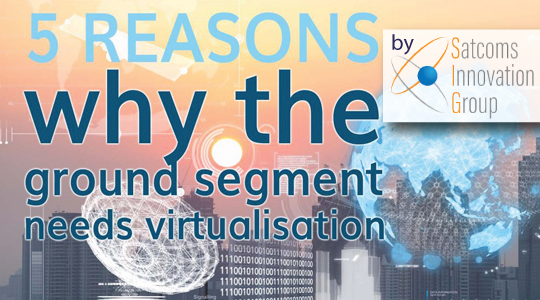 Credit: Satcoms Innovation Group
Credit: Satcoms Innovation Group
The communications industry is being overhauled. With the introduction of 5G and lower earth orbit, the way we deliver services is about to change. Adapting cleverly to these changes will help satellite businesses reap the benefits of new opportunities being made available to the satcom industry. The ground segment is no exception.
Many are now looking at how to adapt the teleport to maximise business opportunities and deliver services to new customers. Here are 5 reasons why we can expect to see virtualisation at the ground segment:
- Satellites are configurable
It’s no secret that hardware-based systems are limited in terms of flexibility and scalability. Planning is required to make the smallest of changes and, even then, can be costly. This is hugely limiting when considering that a satellite itself is configurable; it may prevent the customers from receiving the services being offered by the satellite operator. Virtualising the ground segment delivers the cloud-based benefits we have all become accustomed to: low costs, easy expansion, and flexible scalability. Ultimately, providing customers with an adaptable service is to provide them with a better service.
- Adjusting to LEO
The intricacies of LEO are set to be a challenge for the ground segment; both satellites and data will be passed from one gateway to another. With the sheer number of LEO gateways required to manage data from constellations, software solutions are being seen as the best route forward. Cloud-working delivers improved operational and cost efficiencies, as well as dynamic and configurable systems allowing service providers to remain competitive; this is incredibly important within LEO.
- Cloud-based RFI data processing
The complexity of the ground segment will see many operators turning to intelligent management systems to monitor teleports. Even now, RF interference continues to be a consideration within satcom. As data service links try to maximise bandwidth, RF link issues can impact the throughput and efficacy of the link. As space becomes more dynamic, rectifying RFI is going to become far more complex. Many believe that AI will be the only way to manage networks. This will see data processing being moved to the cloud and the ground segment will need to integrate accordingly.
- 5G interoperability
5G is set to have a substantial impact on communication networks. It makes sense to look ahead and ascertain where satcom will have a role in the infrastructure and position itself as a vital part within the overarching communications network. Interoperability is key; we need to make sure that both our software and hardware is compatible with 5G in anticipation of 5G’s use of satellite links within its network.
- Our customers are already using cloud-based infrastructures
Importantly, we need to ensure that our services slot in with our customers’ workflows. With many organisations already taking the leap to cloud-based working, it is logical for the industry to align with our customers. Businesses are shifting to the cloud as it offers responsive and dynamic workflows, therefore it is imperative that the satcom industry enables this type of working through its own methods. Virtualisation will enable interoperability with customers, enabling quick rollouts of services and a better customer experience.
The perfect time to look at the wider picture
As the industry plans to virtualise its ground segments, now is a brilliant time to look forward at the wider picture and adapt the teleport to fit within the overarching communications network. Instating technology that will maximise opportunities will ultimately sustain growth within our industry.
Read more from SIG.
